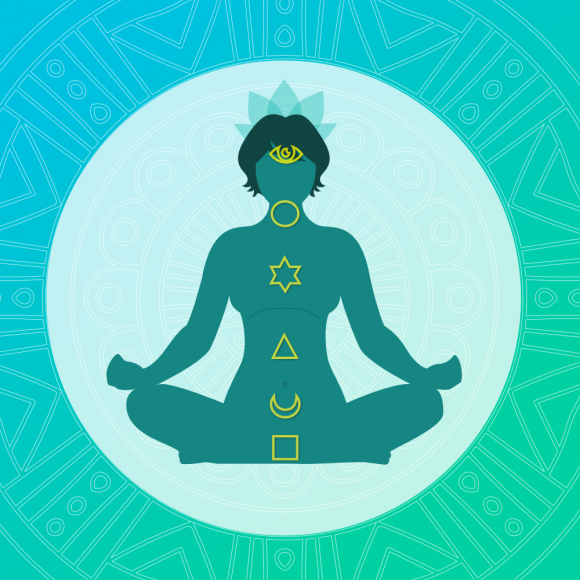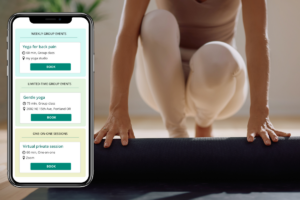 For ancient yogis, chakras were potent energy centers along the main energetic channel of the body (sushumna nadi). This is where the secondary energetic channels (ida and pingala) are said to cross. The intersection of all three major channels creates energy concentrations that affect our functioning. When the energy is flowing freely, the chakra wheels are said to be spinning smoothly, much like water wheels under the smooth flow of water. When the energy becomes clogged, the chakras’ functioning is affected, and all sorts of problems sprout up in the affected area.
For ancient yogis, chakras were potent energy centers along the main energetic channel of the body (sushumna nadi). This is where the secondary energetic channels (ida and pingala) are said to cross. The intersection of all three major channels creates energy concentrations that affect our functioning. When the energy is flowing freely, the chakra wheels are said to be spinning smoothly, much like water wheels under the smooth flow of water. When the energy becomes clogged, the chakras’ functioning is affected, and all sorts of problems sprout up in the affected area.
You can think of chakras as clusters of beliefs around specific needs that we all have (e.g., safety, procreation, achievement, love, self-expression, meaning, and inspiration). Each of us has a wide variety of beliefs about these needs, affecting our perceptions and actions. When these beliefs get us what we need, they are effective, but if we keep struggling with the same issue over and over, then something in that cluster of beliefs is sabotaging our best efforts. And if we want to get these needs met, we need to re-evaluate these beliefs. Chakra work allows us to do that, serving as a map to help us figure out where we are on the spectrum between function and dysfunction on the level of each need. Chakra work is meant to anchor our attention in a specific body area and use it as a focusing device to work out the issues that we are dealing with on each chakra’s level. We can use symbols associated with each chakra to unearth our beliefs and potentially change them.
READ MORE ABOUT THE CHAKRA MODEL >
Sequence Wiz allows you to record your findings as you conduct a Personality of your student using the Chakra model.
How to conduct a basic personality assessment
The personality is formed based on inherent tendencies and is affected by our experience and conditioning. It has great potential for transformation. The Chakra model can serve as a map of personality.
Not every student will be open to an intentional dive into their deepest beliefs and analysis of the innermost layers of their personality. Before you begin this kind of work, be sure that your student is interested and open to that exploration. You don’t have to use chakra terminology to have important conversations with your students about their views of the world and their ways of interacting with it. If the student is not willing to do this kind of inner processing, you can use your own assessment of their personality to better tailor your yoga practice to their needs.
- Assess where the student stands on the level of each chakra through conversation and observation. This will serve as a jumping-off point. You can approach this investigation systematically, from the ground up, exploring each chakra and the beliefs your student has associated with it, or you can focus on the one that keeps coming up. For example, if the student keeps circling back to their fears, insecurities, and feelings of instability, you might decide to zoom in on muladhara (the root chakra).
- Get a sense of whether the beliefs around a specific chakra have a connection with the student’s current challenges. Analyze the symptoms of discomfort that your student communicates and note whether they seem to be connected to an imbalance in a particular chakra. For example, if the student complains of a frequent upset stomach and feelings of anxiety while also lacking self-confidence and willpower to handle the smallest challenges, it might point to an imbalance in Manipura (the navel chakra).
- Summarize your observations about the student’s current state. After recording your notes about your student’s chakra imbalances and obvious related symptoms, you can summarize your thoughts and formulate a vision of what you think is going on from the perspective of the Chakra model.
- List your practice recommendations. Based on your summary, you can devise a course of action and outline the strategies to implement into your work with your student. Rather than focusing on why the student has trouble with a particular chakra, it works better to encourage them to embody the balanced qualities of the chakra that they would like to cultivate. Symbolism works great for chakra work. Use relevant and meaningful imagery—elements, senses, animals, deities, and gestures— as focusing devices to cultivate the desired qualities. For example, you can use the image of a mountain to symbolize stability, the image of an eagle to enable your student to see the bigger picture, or the image of water to cultivate the feeling of fluidity.


Leave A Comment?